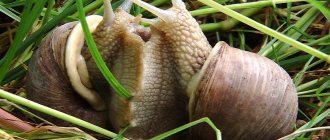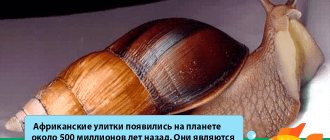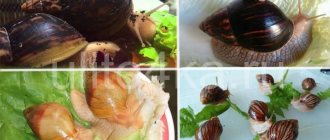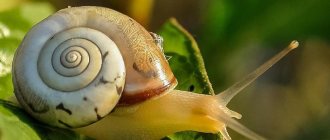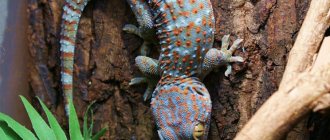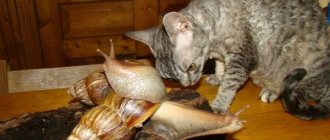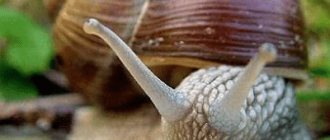Origin of the species and description
Photo: Achatina snail
Achatina or gastropod, belonging to the order of pulmonate snails, suborder of stalked-eyes, family of Achatna. The first gastropods inhabited our planet from the beginning of the Cretaceous period of the Mesozoic era. The oldest gastropod fossils are almost 99 million years old. The ancestors of gastropods were the ancient ammonite mollusks, which existed from the Devonian period to the Cretaceous period of the Mesozoic era.
Video: Achatina snail
Ammonites were very different from modern snails. Ancient snails were predatory and more similar to modern molluscs Nautilus pompilius. These mollusks swam freely in the water and were of enormous size. The species Achatina fulica was first described by the French zoologist Baron André Etienne Ferussac in 1821.
Achatina are a whole group of land snails which includes such species as:
- achatina reticulata;
- achatina Craveni;
- achatina glutinosa;
- achatina immaculata;
- achatina Panthera;
- achatina Tincta;
Achatina are large snails with a long shell of 8-15 cm, however, there are also very large specimens whose shell size is more than 25 cm. The snails have a canonical-shaped shell, twisted counterclockwise. On average there are about 8 turns on a shell. The color of a snail can vary and depends on what the snail eats. Basically, yellow and brown tones predominate in the color of Achatina. The shell often has a pattern of yellow and red-brown stripes.
Archachatina
These types of archaeologists are often kept at home:
Archachatina degneri
The average shell size is 10-12 cm. The main color is brown or red-brown with yellow stripes, the apex is beige. Columella is crimson or purple in color.
Archachatina marginata
Archachatina marginata eduardi
A small shell - 8-10 cm, striped with a predominant brown color. The apex is beige or yellow. Columella is bluish-white.
Archachatina marginata egregia
Snails with small shells - 8-10 cm. The shells are bright, with predominant dark tones, and two-tone colors are common. Apex pink. Columella crimson color.
Archachatina marginata marginata
It is distinguished by a massive rounded shell, the average length of which is 16-18 cm. Color - light and dark brown stripes, evenly distributed stripes on a yellow background, with spots and inclusions. Columella is white. The color of the apex is a pale pink shade or not colored. The leg is a rich dark color.
Archachatina marginata var. ovum (Archachatina marginalata ovum)
The size of the shell of representatives of this species can reach up to 18 cm. A distinctive feature from other arches is the yellow apex. The main color of the shell is a yellow or beige background with brown stripes. Columella is yellow or peach in color.
Archachatina marginata var. suturalis (Archachatina marginalata suturalis)
Representatives of this species are distinguished by a bright pink apex and pink or crimson columella. The average size of the shell is 12-14 cm. The color of the shell is slightly darker than that of ovums.
Archachatina papyracea
The size of the shell can reach up to 10 cm. The first turns are beige-brown, striped, the last turn is monochromatic with a brown or greenish tint. Columella has a crimson or purple hue. The apex is more pointed than in other representatives of the genus, and is beige in color.
Archachatina puylaerti
The size of the shell is up to 12 cm. The first whorls are beige-brown, striped, the last whorl is greenish, olive or brown-green with stripes or spots, the apex is beige. Columella crimson or purple.
Archachatina ventricosa
The shell size is up to 12 cm. The first whorls are red-brown in color, the large whorl is olive or bright green with brown stripes and spots. The apex is yellowish or reddish. Columella is raspberry or purple in color.
In this article, we tried to describe the types of Achatina and the types of Archatina that are most often found in home collections. We will talk in more detail about each type in separate articles. Health to you and your pets!
Appearance and features
Photo: What does the Achatina snail look like?
Achatina are large terrestrial gastropods. The shell size of an adult is from 10 to 25 cm in length. The weight of the snail is about 250-300 grams. Under favorable conditions, the weight of the mollusk can reach 400 grams. The body is plastic, up to 16 cm in length, completely covered with a pattern of small wrinkles. The structure of the snail is conventionally divided into two functional parts: the cephalopodium—the head and leg of the mollusk—and the visceropallium (torso).
The head of the mollusk is quite large, located in the front of the body. The head has small horns, cerebral ganglia, eyes and a mouth. The snail's eyes are located at the ends of the tentacles. Snails see poorly. They can only distinguish the shapes of objects at a distance of 1 cm from the eyes. Able to distinguish between light intensity. They really don't like bright light. If sunlight hits the snail, the mollusk begins to hide. The oral cavity is well developed. Inside there is a tongue with spikes on it. Thanks to this structural feature, the snail can easily capture food with its tongue.
Interesting fact: Snails of this species have as many as 25 thousand teeth. The teeth are strong and made of chitin. With the help of teeth, the snail grinds hard pieces of food.
The snail's foot is strong, with a large wrinkled sole, with the help of which the snail can move along both horizontal and vertical surfaces. The glands of the snail secrete special mucus, which promotes gliding and better suction to the surface. The inner bag is protected by a strong shell. The snail has a fairly simple internal structure of organs: a heart, a lung and one kidney. The heart consists of the left atrium and ventricle surrounded by the pericardium. The blood is clear. The snail breathes air through its lungs and skin.
The shell of the mollusk is strong and durable. The number of turns corresponds to the age of the mollusk. The shell color of even mollusks of the same subspecies can vary greatly. The color of the shell depends on the snail’s diet and the conditions in which the individual lives. The average lifespan of these mollusks in the wild is 11 years; in captivity, these creatures can live much longer.
Interesting fact: Achatina, like many other snails, have the ability to regenerate. That is, the snail is able to regrow the lost part of the body.
Archachatina marginata var. Egregia
Conditions for keeping Arhachatina marginalata var. Egregia (Archachatina marginata var. Egregia)
Temperature: 28-30 degrees
Humidity: 80-85%
Columela color: crimson
Dimensions of an adult: up to 15 cm, more often 10-12 cm
Number of eggs: 8-14
Egg size: large
Archachatina marginalata var. Egregia is a rare species in Russia and Ukraine. Archachatina marginata var. Egregia comes from Cameroon. Color: yellow-black stripes, blurred and not clearly distinguishable from each other. The apex and columella are crimson in color. The leg is dark, almost black, but in the light it casts silver. The length of a snail shell can reach 15 cm, but is often within 10-12 cm. At the same time, the diameter of the shell is about 8-9 cm. Therefore, the shell of this species has a round shape.
Archachatina marginata var. Egregia is not too picky about its maintenance, but you can also encounter certain difficulties with them. Firstly, those who like to hold a snail in their hands and watch it make faces are unlikely to expect anything like this from Egregia. Egregies don't like hands! Moreover, snails are very shy and afraid of any loud sounds. Sometimes it takes more than an hour to take a couple of photos.
Secondly, the snails Archachatina marginalata var. Egregia are nocturnal inhabitants. They don't like bright light. They won’t swim outside their “home” either.
But, despite the fact that their appearance is not distinguished by anything special, and taking into account their secrecy and unsociability, Arhahatina is marginata var. Egregia are distinguished by impressive “reasonableness”
Archachatina marginata var. Egregia are jealous of their territory and other types of snails, absolutely any, will be attacked and bitten very badly. But they get along with representatives of their own species without any incidents. Most of the time Archachatina marginata var. Egregia is carried out underground, burrowing into the ground. But they don’t dig it in different places, but use a hole that has already been dug earlier. The toilet is located in one corner of the terrarium. They love to swim, but only in the dark and in solitude. Particularly reverent is Arhahatina marginata var. Egregia treat their clutches - not only do they not crush or eat the eggs, but they also bury themselves next to them and guard them. Therefore, it is necessary to remove eggs from the common terrarium, since the snails refuse food and do not want to leave their “watch.” After removing the eggs, they return to their normal lifestyle.
They become sexually mature at the age of 1-1.5 years. They do not make fat deposits. Eggs of Archachatina marginata var. Egregia is gestated for about 1 month. They lay on average up to 14 eggs, but often their number does not exceed 8 pieces. The snail may not leave its shelter in the ground for 3-4 days when the eggs are laid. They should not be disturbed at this time. The clutch lies for 24-30 days, after which small Archachatina marginata var. are born with almost 100% survival rate. Egregia.
| Next > |
Interesting article? Share it with others:
Where does the Achatina snail live?
Photo: Achatina snail at home
Africa is considered the homeland of Achatina. Initially, snails lived only in the warm and humid African climate, but over time, thanks to humans, these snails spread throughout the world. Achatina currently live in Ethiopia, Kenya, and Somalia. In the 19th century, snails were introduced to India and the Republic of Mauritius. Closer to the 20th century, these snails found their way to the island of Sri Lanka, Malaysia, and Thailand. At the end of the 20th century, these snails were brought to California, the Hawaiian Islands, Ireland, New Guinea, and Tahiti.
Interesting fact: Achatina snails are quite smart mollusks; they are able to remember what happened to them during the last hour, remember the location of food sources. They distinguish tastes perfectly and have taste preferences. Domestic snails are able to recognize their owner.
And also at the end of the 20th century, these snails were discovered on the Caribbean islands. They prefer to live in places with a warm and humid climate. It is active after rains at air temperatures from 10 to 30 °C. At high temperatures, it goes into torpor, covering the entrance to the shell with a layer of mucus. At low temperatures from 8 to 3 °C it goes into hibernation. These snails are unpretentious to external conditions, and were able to master life in almost any biotype. Achatina can be found in forests, parks, river valleys and fields.
It can settle near human habitation and is considered an invasive species. The import of these shellfish into the territory of many countries is strictly prohibited. In America, importing Achatina is punishable by a prison sentence. Harmful to agriculture.
Now you know how to keep the Achatina snail at home. Let's see what to feed this gastropod.
Story
Achatina were brought to Europe from southern exotic countries. They live in large numbers in Africa, South America, Mauritius and other southern islands. Due to their enormous fertility, they are able to quickly populate entire colonies over vast territories, eating vegetation and damaging agricultural land. Therefore, in some tropical countries it is prohibited to breed and sell them. But in the temperate climate zone they do not survive and are able to reproduce only in artificial conditions.
They are considered the largest among all types of snails. The size of an adult individual can reach 20 cm. This snail attracts with its gentle disposition, lack of noise, odor and allergies, as well as a variety of shell colors.
What does the Achatina snail eat?
Photo: Large snail Achatina
Akhetines are herbivorous mollusks that feed on green vegetation, vegetables and fruits.
The diet of Achatina snails includes:
- sugar cane;
- tree buds;
- decaying plant parts;
- spoiled fruits;
- fruit tree leaves;
- grape leaves, lettuce;
- clover;
- dandelions;
- plantain;
- alfalfa;
- nettle;
- fruits (such as avocados, grapes, pineapple, mango, cherries, apricots, pears, apples);
- vegetables (carrots, cabbage, zucchini, beets, pumpkin, lettuce);
- bark of trees and shrubs.
At home, snails are fed vegetables (broccoli, carrots, lettuce, cabbage, cucumbers, bell peppers). Fruits apples, pears, mangoes, avocados, bananas, grapes. Melons. As complementary food, you can also give these pets oatmeal, cereals, bone meal and ground nuts in small quantities. For the proper development and growth of shells, Achatina need to be given additional sources of minerals - chalk, finely ground eggshells or shell rock.
These substances should be given in small quantities sprinkled on the main food. Adult Achatina easily cope with solid food. Small snails can be fed with fruits and vegetables, grated, but you should not give puree as the babies can simply suffocate in it. In addition to food, pets should always have water in their drinking bowl.
Interesting fact: Achatina are quite hardy creatures; they can go without food for several days, and this will not harm them. In the wild, when Achatina cannot find food for a long time, they simply hibernate.
Features of character and lifestyle
Photo: African snail Achatina
Snails are very calm creatures leading a quiet existence. In the wild they live alone, or they form a pair and live together in the same territory. They cannot exist in the form of a herd for a long time; a large concentration of adults leads to stress. Therefore, during overpopulation and a sharp surge in population growth, mass migration of Achatina may begin.
Achatina are active after rain and at night. During the day, these mollusks come out of hiding only when it is humid outside. On sunny days, snails hide behind stones, among the roots of trees and in thickets of bushes from the sunlight. They often bury themselves in the soil to avoid overheating. Young snails can move quite long distances and are not tied to resting places. Older individuals are more conservative and for recreation they arrange a certain place for themselves to rest and look for food for themselves near this place, trying not to move more than 5 meters away from it. Moving very slowly, Achatina crawls an average of 1-2 cm in one minute.
In the wild, with the onset of unfavorable living conditions, Achatina burrows into the ground, covers the gap in the shell with a special adhesive film of mucus and hibernates. It should be noted that hibernation is more of a protective mechanism; the snail does not need sleep, it does this in order to wait out unfavorable environmental conditions. Domestic snails can also hibernate if kept in poor conditions. This usually happens when the snail does not have enough food, or its nutrition is unbalanced, if the air in the terrarium is too dry, if the pet is cold, or is stressed.
It should be noted that long hibernation is not good for mollusks. During sleep, the snail loses a lot of weight; in addition, during prolonged sleep, at the entrance to the shell, in addition to the first film with which the snail closes its shell, more similar films of mucus are formed. And the longer the snail sleeps, the more difficult it is to wake it up. To wake up a snail after sleep, you just need to hold it under a stream of warm water and after a while the snail will wake up and get out of its house. When waking up, provide the snail with good conditions and increased nutrition.
Content
Keeping Achatina snails is quite simple, because they are unpretentious. They do not require a special terrarium. A simple glass aquarium will do. You can take an old one that is not even very sealed. The top of the snail's house should be covered with glass or plexiglass, but not tightly - leave a gap so that the pet has something to breathe. You can make holes in the lid. If the aquarium is not closed, the snail will begin to travel around the owner's house.
Unfertilized peat or coconut fiber substrate purchased at a pet store is poured onto the bottom of the aquarium in a layer of 5-10 cm. The latter must first be soaked according to the instructions. The soil acts as a soft bedding so that the snail does not break if it falls away from the wall of the aquarium.
Flower mixtures from gardening stores cannot be poured onto snails due to the presence of fertilizers and sawdust that are deadly to the mollusk. Clean forest or garden soil is disinfected with boiling water before filling.
Mandatory condition: to maintain the optimal level of humidity in the terrarium, the soil must be periodically moistened. This should be done strictly when necessary, since both drying out and waterlogging of the substrate is harmful.
The Achatina snail loves to swim, for which you need to place a shallow container of water in its home and change it regularly. For example, a saucer with some water.
It is good to place shelters made of driftwood, boulders, halves of flower pots and coconuts in the house. The air temperature in the Achatina house should be 24–27 C. The low temperature can be raised using a lamp with a dim glow. However, the animal tolerates a slightly lower temperature normally, but becomes less active.
Social structure and reproduction
Photo: Giant snail Achatina
The social structure of snails is undeveloped. More often Achatina lives alone, sometimes they can live in the same territory in pairs. Snails do not build families and do not care about their offspring. Achatina are hermaphrodites; any individual can perform female and male functions. In extreme conditions, snails are capable of self-fertilization, but this happens in rare cases.
Individuals ready for mating crawl in circles, slightly lifting their body forward, sometimes stopping, as if looking for something. When two such snails meet, they begin to communicate, feel each other with their tentacles, and crawl in a circle. Such mating dances can last up to 2 hours, after which the snails fall together, sucking on each other.
If the snails are the same size, fertilization occurs in both snails. If one snail is larger than the other, then the female snail will be a large snail, since the development of eggs requires a lot of energy. Snails are small in size, even adults always act as males, while large specimens act as females.
After mating, the snail can store sperm for several years, which is gradually used for newly matured eggs. During one litter, one individual lays about 200 eggs; under favorable conditions, the clutch size can be increased to 300 eggs. In one year, one individual can make 6 such clutches. Pregnancy in snails lasts from 7 to 14 days. The female forms a clutch in the ground. After the snail lays its eggs, it forgets about them.
The eggs are small, about 5 mm in length, slightly elongated. After 2-3 weeks, small snails hatch from the eggs. Small snails grow very quickly for the first 2 years, after which the snail's growth slows down greatly. Juveniles reach sexual maturity at the age of 7-14 months, depending on the individual characteristics of each individual and living conditions.
Review Reviews
Owners of Achatina snails are quite willing to share information about their pets. Most reviews look very optimistic and allow you to appreciate all the advantages of such pets. It is interesting that many people become owners of such unusual pets by chance. And only then, having completely fallen in love with the unusual and very easy to care for creatures, they begin to purposefully breed them.
It doesn't come without complications. Unprepared owners of exotic Achatina face a lot of difficulties in the first weeks of life with their pet. For example, maintaining a certain level of substrate moisture and selecting it often seems too complicated. The new owners also do not know about the prohibitions on salt and spices; they try to offer the snail food generously seasoned with various additives.
The delight that Achatina evokes in the people around them is especially often mentioned. Friends and relatives who come to visit are guaranteed to be busy for several hours just contemplating the pet. The birth of offspring can be a big surprise for owners - congenital hermaphroditism and the ability to self-fertilize can give unexpected results even with long-term solitary keeping of Achatina. If you overlook the clutch, there is a risk of becoming the owner of several dozen Achatina at once.
For more information about Achatina, see the following video.
Natural enemies of Achatina snails
Photo: What does the Achatina snail look like?
In their usual habitats, Achatina snails have a lot of enemies in the wild, thanks to which the number of these mollusks is regulated.
The main enemies of mollusks in the wild are:
- large lizards;
- toads;
- moles;
- mice, rats and other rodents;
- large birds of prey such as falcons, eagles, crows, parrots and many others;
- Genoxys snails.
However, we should not forget that in many countries, especially where the import of these snails is prohibited, due to the large size of the mollusk and the characteristics of the fauna, snails may not have enemies. In this case, the uncontrolled reproduction of these mollusks can turn into a real disaster, because they multiply quickly and populate large areas. And besides, snails eat all the greenery that they encounter on their way.
Achatina are parasitized by many types of helminths, the most unpleasant of which are nematode worms and trematode worms. These worms can live in the shell of a snail, also on the body of a mollusk. A mollusk suffering from parasites becomes lethargic, and if it does not get rid of them, the snail may die. In addition, snails can infect other animals and humans with parasitic diseases. Achatina also suffers from fungal diseases; when exposed to hypothermia, they can catch a cold, but usually under unfavorable conditions the snails hibernate.
